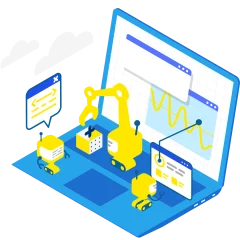Most people associate the monolith as a large and compact whole. Coming from nature, it is the name for a uniform, indivisible rock. And this also applies to software: In software development, when we talk about monoliths we are talking about an architecture in which an application is developed as a unified and indivisible whole. A monolithic system links all functions closely together and integrates them into a single code base.
Example of a monolith in web development
Over time, many web applications have evolved from a monolith into distributed systems (microservices). A prominent example is Facebook, which in its early days relied on the LAMP stack: the Linux-based server, Apache web server, MySQL database and PHP runtime environment. This technology stack has held up well over many years, before it was no longer able to cope with the growing demands of a platform with millions of users.
However, it must be mentioned that LAMP was also the only way to build robust and cost-effective web applications at the time. With the MERN approach (MongoDB as a database server, Express.js for backend development, React.js for frontend development, Node.js as a runtime environment), LAMP 2.0 has evolved. Applications can be created much more easily here with just one code base and can still be easily split up afterwards.
Benefits of the monolithic approach
Projects on a small or medium scale can be ideally suited to a monolithic project. There are several reasons for this:
- Easy development and maintenance: Since all parts of the application are developed in one code base, the coordination and division of different components is easier.
- Performance and efficiency: Monoliths can be more efficient and powerful in certain scenarios, such as with a smaller range of functions. Interactions within a single application can be faster, as data flows are usually designed more directly.
- Easy scaling: In the beginning, it is often less complex to scale a monolith as it consists of one part. Therefore, you can simply move the entire application to more powerful hardware.
Challenges with monolithic architectures
Of course there are also challenges. These mainly relate to the growth of the application, i.e. growing up:
- Complexity over time: As the application continues to grow, the number of lines of code written also increases. This becomes more and more complex and difficult to manage over time.
- Technological lock-in: The decision of a technology stack is groundbreaking, for the further development of the app. Being tied to one technology platform makes innovation more difficult.
- Difficulties with further scaling: As the application grows, so do the requirements. Each new requirement affects the entire application and certain platforms may not even be able to be used.
Comparison: monolith vs. microservices
The distributed systems mentioned are nothing other than so-called microservices. As a counterpart to the monolith, microservices divide the application into smaller, functioning services. They are often used for large, complex applications. Many monoliths have split into microservices over time. The resulting flexibility not only makes individual services independently scalable and maintainable, but also simplifies collaboration with different development teams. However, this naturally also increases the complexity of the overall system.
When is a monolith the better choice?
It makes sense to start small: Once the software product has been validated, it can always be developed further. A monolithic approach is therefore often ideal for smaller projects or start-ups where speed and simplicity are crucial. Even if the team is small or the application does not need to be updated regularly, a monolith can be the first choice.
Best practices for monolith development
There are a few points to consider to ensure that all the advantages of the monolith are optimally utilized:
- Modular structure: Even within a monolith, it is important to create clear module and component structures to facilitate maintenance and expansion.
- Continuous refactoring: Regular refactoring of the code helps to ensure that the application is always kept up to date. Updating a monolith only after several years increases the workload considerably.
- Automated tests: A solid (automated) test strategy is essential for a solid and reliable system. As with all other good, high-quality software projects.
Conclusion
Monoliths are the solid foundation for many software projects that are still in their infancy. Many prototypes or apps of today’s large corporations initially relied on a monolithic architecture before they (inevitably) migrated to microservices. Start-ups and small teams should therefore think carefully about how much complexity they want to keep for their next software project. Because sometimes less is more.


